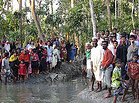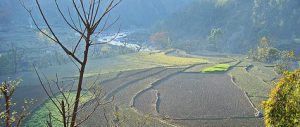When winter comes and the temperatures plummet to -25º Celsius in Ladakh, in the dry, remote eastern corner of Jammu and Kashmir, the price of vegetables triples. They triple, that is, if there are vegetables to be had – if airplanes and trucks can get them into India’s northernmost state. For six months of the year, snowfall largely cuts the sparsely populated region off from the rest of the world, and the people make do with stored root crops and dried leafy greens.
Here in the desert valleys of the western Indian Himalayas, above 3,000 metres, vegetables can be grown outside only during a short summer season. Ladakh’s high altitude and low rainfall mean that crops can be grown for only about 90 days and are reliant on water from melting glaciers. But what the region has in abundance – in addition to stunning scenery – is exceptional sunshine. For more than 300 days a year, the sun beams brightly in cloudless skies.
That sunshine now is being utilised in a pioneering renewable-energy project that helps villagers to grow fresh vegetables year-round in simple solar greenhouses. GERES, a French NGO, has been working with local organisations in Ladakh for more than 10 years to harness the sun’s potential. The result: local people are enjoying their own nutritious produce beyond the short summer season. Thanks to the scheme — honoured recently with a prestigious 2009 Ashden Award for sustainable energy — the villagers produce spinach, lettuce, onions, radishes, strawberries, coriander, garlic and more throughout the year. Eating a balanced diet has become much easier.
Vincent Stauffer, a solar-energy engineer and GERES’ country director for the Indian Himalayan region, explains the project’s success so far: “Our studies show that greenhouse owners eat eight times more vegetables than they did previously and their incomes have increased by around 30%. Their extended families, neighbours and other villages also benefit from buying and exchanging vegetables and flowers. This is leading to better nutrition and health benefits for over 50,000 people — a quarter of the local population.”
In springtime, the greenhouses are used to raise seedlings, while in autumn they help to extend the growing season for tomatoes, cucumbers, grapes and other crops.
The buildings’ design is based on passive-solar concepts. The roughly 10-metre by five-metre structures are built from locally produced mud bricks, with straw- or sawdust-insulated walls. Back roofs are made from poplar and willow wood. Straw or water-resistant local grass is used for thatch to help minimise heat loss. Aligned on an east-west axis, the long south-facing side has a transparent cover made from heavy-duty polythene.
Inside, the west wall is painted white, to reflect the morning sunlight onto the crops, while the north and east sides are black, to improve heat absorption. Vents in the roof, side door and opposite wall help to control humidity and heating levels. To reduce heat loss overnight, a cover over the transparent south side increases insulation, raising the inner temperature by 5º Celsius.
Thanks to this cheap and relatively simple design, hundreds of greenhouses have been installed and some 300 tonnes of extra vegetables a year are produced in the Ladakh region, which shares a border with China to the north and east. Using mainly local materials and labour, the structures can be built after the outdoor growing season ends, when both workers and cash are available. (A larger design, nearly 30 metres long, has been developed for commercial purposes.) A family greenhouse costs about US$600, with owners providing some 75% of the cost and the balance coming from the GERES project.
The benefits to the local people are numerous. Not only do they have fresh fruit and vegetables year round — improving their health and nutrition — but they can enjoy a cash income from selling their excess produce. “Leafy vegetables are the easiest to grow,” says Stauffer. “You cut the leaf and it keeps growing. Turnips are less economical.” A two-hour bus journey to a market is well worth the trip, he notes, and a regular income has made a real difference in people’s lives.
Women, in particular, have been empowered by the greenhouse project. They usually are the growers of the food, bringing to their families the benefits of better nutrition as well as additional income from selling produce in local markets. Through that selling, they can become more independent and economically self-sufficient, and buy other foods and supplies. With an improved financial position, some families are able to afford to educate their children for the first time.
As Sonam Angmo, a local farmer with a GERES greenhouse, said: “I make about 8,000 rupees [US$170] a year from the greenhouse, selling fresh vegetables in the winter and seedlings in the spring. My daughter is 19 and studying in Jammu, and that extra money helps cover her costs. Everyone likes my vegetables, and in fact there’s such a demand for fresh food that we’re now planning on building a second greenhouse.”
According to GERES, the average greenhouse owner provides vegetables for nine other families and exchanges them with six more. In a region where people once ate vegetables perhaps twice a month, they now enjoy them a few times a week.
In the Ladakh region, which has limited opportunities for employment, the greenhouse project helps provide income in other ways. Local men have been trained in masonry, carpentry and other construction skills, while the few larger, commercial greenhouses offer some jobs. To keep the project running smoothly, local resource people visit the greenhouses frequently, supplying advice to their owners.
Traditionally, families in western India’s Himalayas have relied on agriculture (cereals and fruit trees) and livestock-rearing (meat, butter, wool) for their livelihoods. This isolated subsistence system is gradually evolving and being integrated into a local monetary economy. The passive-solar technology of the greenhouses also is being expanded to poultry and lambing sheds, further diversifying opportunities.
The environment, too, is a beneficiary. GERES says that avoiding air and truck deliveries of vegetables cuts carbon emissions by 460 tonnes a year, while composting improves soil fertility and reduces erosion in a dry and dusty region with little biomass.
In conjunction with NGOs, local government bodies or simply individuals, the GERES-led greenhouse project is being replicated elsewhere. Away from the high valleys of Ladakh — and the Lahual and Spiti district in neighbouring Himachal Pradesh state — greenhouses have sprung up in Tajikistan, China and Afghanistan. In the near future, GERES plans to expand them to other parts of the Hindu Kush, as well as to Kyrgyzstan’s central Pamir region.
The Ashden Awards were founded in 2001 to encourage the greater use of local sustainable energy to address climate change and alleviate poverty. In addition to the GERES project, the Aprovecho Research Center, based in the United States, and China’s Shengzhou Stove Manufacturer were honoured this year for their mass production of fuel-wood stoves for global distribution.
Other organisations receiving awards were Germany’s Solar Energy Foundation, for setting up the biggest solar-energy programme in Ethiopia; Saran Renewable Energy (SRE) in India, for a gasification system providing 11 hours of power daily; ECAMI in Nicaragua, for installing more than 400 kilowatt-peak (kWp) of solar photovoltaic systems for home and other uses; Kampala Jellitone Suppliers in Uganda, for producing non-char biomass briquettes made from agricultural waste; and International Development Enterprises India (IDEI) for a simple treadle pump that has lifted hundreds of thousands of farmers out of poverty.
Maryann Bird is associate editor of chinadialogue
Homepage image by Martin Wright/Ashden Awards


